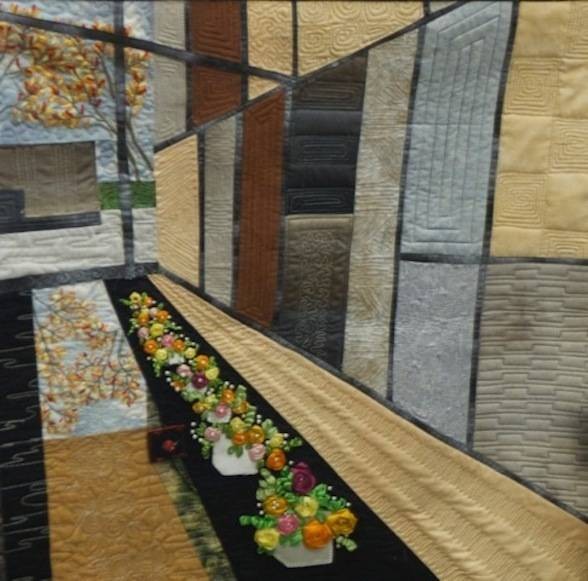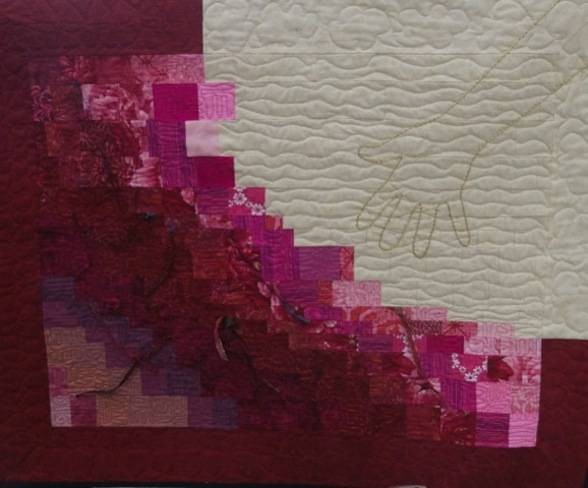[Kitty admires the many skills of three female FBI agents who discovered quilting, and who have translated their medium to replicating Impressionist artworks. — the Artblog editors]
You’d think that FBI agents had enough to do, what with tracking down violent criminals, transcribing wiretaps, and taking regular target practice.
Not so for three female agents. They discovered a complementary passion–quilting–in a high school evening class, and later named their venture “The Needle and Gun Club,” after one agent popped her trunk after target practice to show her latest quilt.
By then, the group had expanded to include relatives of the agents; artists; educators from elementary to college level; a podiatrist; and other health professionals, who didn’t mind the moniker.
Now, 21 years later, their onetime passion has turned to art.
On Sunday, March 1, the quilters exhibited 13 of their most-inspired masterworks–24-inch square quilts–influenced by Impressionist paintings at the Barnes Foundation. In the Barnes’ Annenberg Court, each showed her quilt with a photo of the painting that motivated her.
Right on target

Monet’s only self-portrait in 1864, “Studio Boat,” gave Judy Tyler, a retired FBI agent, the impetus to shop for fabrics that would approximate the artist’s brush strokes. Her investigation led her to The Village Quilter in Mount Holly, N.J., where she found a fabric with a green flower that made “a great tree line” and discovered Angelina metallic fibers that she wove across a depiction of water to make it glisten like the painting. She found a fabric of brown fungus that nearly duplicates the bottom of the boat in which Monet sits.
And this from an agent whose drug investigation led to a life sentence for North Philadelphia cocaine boss and hip-hop promoter Maurice Lewis in 2003. Tyler, who now works in a different quilt shop, still teaches FBI recruits part-time in Quantico, Va.
The exhibit drew the curious as well as other quilters, quilt shop owners, and current and retired FBI agents, some of whom received personalized quilts from members of the group–stitched gun included–upon retirement.
The exhibitors also had a table where visitors could look at a copy of a painting and create a section, made from colored paper and glue sticks, much like the quilters piece out their quilts with swatches of material.

The needle for forgiveness
When Janet Cohen first visited the Barnes to become inspired, she put her iPad on a counter in the Annenberg Court to talk to the other quilters. When she looked up, she realized the “counter” was a water feature and her iPad had floated six feet away (to its destruction?). So she took a photo of that corner of the Barnes, which she then turned into a quilt, enhanced with a carefully stitched and quilted mini-iPad on a piece of elastic, that could “float” back and forth on the quilt.
“That’s amazing,” said Diana Sandberg, a visitor, who watched a demo of the iPad “floating”.

Another quilter, Cindy Winter, visited the Barnes, and while studying Horace Pippin’s 1940 painting, “Christ and the Woman of Samaria,” became flushed with forgiveness for a friend, who had been having an affair when she killed her husband, and was now sitting in jail.
Using the brilliant reds and white from the painting helped Winter depict her thoughts on such relationships. Three quarters of the lower part of her quilt are reds, made in small squares, as if in mazes with no way out, or swirls with nowhere to go. Frayed threads, knotted threads, entangled threads emerge from some squares, representing the relationships from which we can’t seem to get away. The top third of the quilt is white, with an outline of an outstretched hand emerging from puffs of clouds, as if offering a hand of forgiveness.
“This [quilting] was the way Cindy Winter forgave her friend,” said Tyler.
Linda Vizi, who served as FBI spokeswoman before retiring in 2002, was struck by the pastel colors–greens, blues, oranges, grays–of the Impressionist paintings and bought fabrics in those hues before becoming inspired by Modigliani’s portrait of Jeanne Heduterme, the artist’s girlfriend. In making her quilt, Vizi said she learned a new technique to make stars.
“And I was going to use it,” she added. “So that’s why the stars are there.”
Karen Dever, a former art teacher who became a certified quilt insurance appraiser, could not put a price on the women’s works, as “That’s private.”
But in a valuation, she considers whether a quilt is “antique, vintage, contemporary, or fiber art,” and then “what it would cost to reproduce it with the same materials, fabrics…from conception to binding and label.”
Several quilters said that Dever often tells them they’re not making quilts; “They’re making art.”









